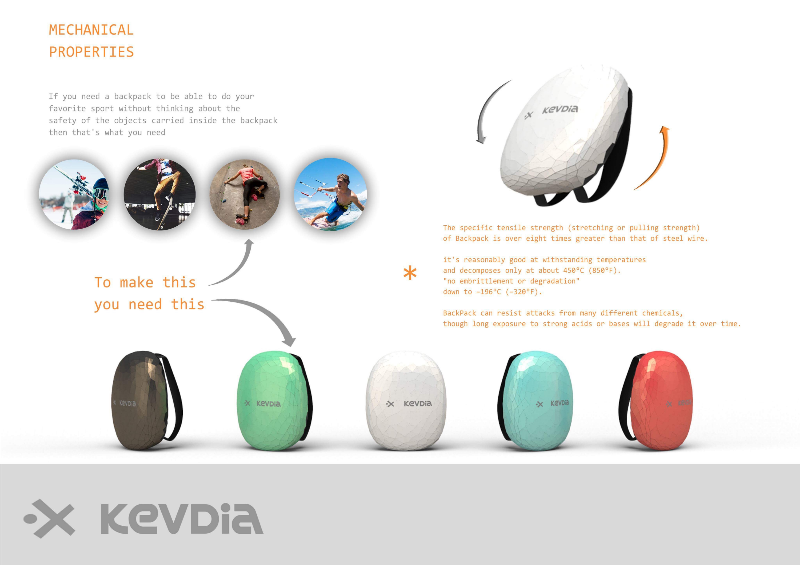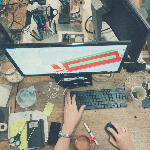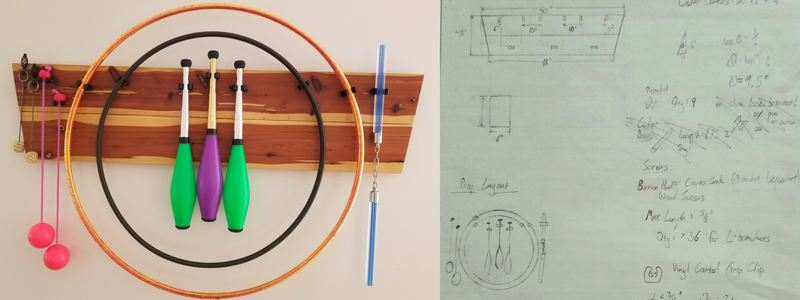Whether you are searching for your first gig, or are a seasoned professional looking to expand your client list, a great portfolio is the most important tool in your arsenal. A portfolio that truly showcases your work will help you get the design jobs that appeal to you the most. Getting it right isn’t always easy, so here are 13 tips for creating the best freelance industrial design portfolio.
Tips to Create a Portfolio as a Freelance Industrial Designer
1. There’s more to design than just the finished product
One of the most common mistakes made when creating an industrial design portfolio is showing only the finished product. This might tell the person reading your portfolio a little bit about your skill level, but certainly not everything you’d want them to know.
When creating your portfolio, start from the beginning of a project and show how you arrived at the completed product. This gives your potential client the chance to see your creative process for the design of a product.
If your design was a team effort, specifying which parts of the process were your own work can also be helpful. It can be frustrating for recruiters to look at a massive project, and not know how much of the work was actually yours.
Design by Michael Dimou
2. Constraints – Don’t be afraid to mention the design limits you were given
While you should only show work you’re proud of; sometimes even your best designs have areas that aren’t all that they should be. Many times this isn’t something you can control but is the result of working under constricting requirements from your client. If you’re showcasing a product with design limitations, explaining these limitations can help the new client see how you follow direction and work within a company’s needs.
Including the limitations of a product is important, but it should never be done at the expense of the previous client. If you express the limitations by placing blame, by saying something like, “I can’t believe they chose that!” your recruiter may end up wondering if that’s how you’ll talk about them at your next interview. Instead, be polite. You’ll leave a better impression, and still make it clear you’re aware of the design flaws.
3. Have two portfolios for optimum results
 If the recruiter interested in your work has already seen the portfolio you bring to the interview, there isn’t anything surprising or interesting to help sell your work. The portfolio you first submit should be a sample of the one you bring to the interview. New products, and even better work, will go a long way toward impressing your potential client.
If the recruiter interested in your work has already seen the portfolio you bring to the interview, there isn’t anything surprising or interesting to help sell your work. The portfolio you first submit should be a sample of the one you bring to the interview. New products, and even better work, will go a long way toward impressing your potential client.
For the first portfolio, choose a small selection of your favorite products to showcase your work. The first portfolio should be extremely concise, with no more than ten products in it. The full portfolio should contain more products and can include more about the development process, as well as showcasing your latest work.
4. Eliminate the fluff
Even if you have successfully created dozens of products, you don’t need to include all of them in your portfolio. One of the biggest mistakes recruiters report is that potential freelancers don’t bring their best work to the table. Their portfolios are often a hodgepodge of everything they’ve ever done, even if those products weren’t the best examples of their work. The interview is where you’re trying to present yourself in the best possible light, so it makes little sense to give your potential client a look at some of your worst designs.
Even the full portfolio you bring to the interview should be a collection of your best work. This is especially the case if you’re adding products you aren’t proud of just to lengthen your portfolio. A short, succinct portfolio with powerful products is better than a long and boring one.
Cut out bad projects entirely and highlight the ones that are similar to what the company is hoping to have designed.
5. Pay attention to your portfolio size
 Emailing your portfolio won’t do you any good if it gets bounced back to you. Compress the files before emailing any digital copies so they won’t bog down your potential client’s inbox, or worse, never make it there at all. Making a good impression is important, and part of that is thinking of small details such as this one.
Emailing your portfolio won’t do you any good if it gets bounced back to you. Compress the files before emailing any digital copies so they won’t bog down your potential client’s inbox, or worse, never make it there at all. Making a good impression is important, and part of that is thinking of small details such as this one.
Size is also important when going to a face to face interview. A huge portfolio with thousands of products isn’t going to be read all the way through, and while it may show you have experience, it’s also going to be too unwieldy to look at comfortably. Many interviewers recommend no more than twenty projects when preparing your full portfolio, so choose only the best ones when putting it together.
Of course, a portfolio with just one or two projects won’t give the client a clear picture of your skill level. Choose a good mix of products, but don’t go overboard.
6. Create an online portfolio
 A quality online portfolio can help you attract new clients and make it easier to keep current clients updated on your latest work. While a hard copy of your portfolio is equally important, especially for face to face interviews, the power of an online portfolio can help you land initial jobs and reach people across the world.
A quality online portfolio can help you attract new clients and make it easier to keep current clients updated on your latest work. While a hard copy of your portfolio is equally important, especially for face to face interviews, the power of an online portfolio can help you land initial jobs and reach people across the world.
There are plenty of great products out there that can help make putting together an online portfolio easy and having one available for potential clients to see at any time may help garner more interest.
7. Customize your portfolio for the job you want
A lot of thought goes into the creation of your portfolio, but it isn’t enough to just do your best one time and then use it for every job application that comes your way. In order to give yourself the best chance at landing the job you’re applying for, you need to tailor your portfolio to it.
Showing a recruiter not just the most recent products you’ve designed, but also the products that show you understand what they’re looking for, gives off a much more professional vibe. If you’re trying to grab a highly coveted contract, taking the time to personalize your portfolio for the company you’re interested in is well worth the extra research and effort.
8. Be confident when discussing your portfolio
 Your portfolio is how a potential client judges your work, but you’re also a big part of it too. If all you do is shove your book at them and say nothing while they look through it, you might as well not be part of the interview. Be prepared to discuss the different products you have designed, and how you came up with your ideas.
Your portfolio is how a potential client judges your work, but you’re also a big part of it too. If all you do is shove your book at them and say nothing while they look through it, you might as well not be part of the interview. Be prepared to discuss the different products you have designed, and how you came up with your ideas.
Choose projects you feel enthusiastic about, so your client can have a chance to see the passion that drives you.
9. Prepare a backup portfolio
 When it comes down to plain and simple photos, a tablet is the easiest way to share your work. Some things simply can’t be communicated through a screen, however, so don’t be afraid to have your printed portfolio on hand, too. That way, if a problem comes up with either one, you’ll have a backup to keep the interview running smoothly.
When it comes down to plain and simple photos, a tablet is the easiest way to share your work. Some things simply can’t be communicated through a screen, however, so don’t be afraid to have your printed portfolio on hand, too. That way, if a problem comes up with either one, you’ll have a backup to keep the interview running smoothly.
Having both forms of your portfolio on hand for the interview won’t just help you to be more prepared, it will communicate to the recruiter that you’re always prepared for mishaps. If your tablet battery dies, or coffee gets spilled all over your book, a backup tells the interviewer you’ll be prepared if a crisis happens in the design process.
10. Tell the story of your product
Most of your designs probably came about because a client requested them, but that isn’t all there is to the product. Why you chose the design features that made it unique, what excited you about the project, and how the product impacted you personally are part of it, too. Sharing the story of how a product came to exist is a great way to help your portfolio stand out from the dozens of others the recruiter is looking at.
Stories don’t just help explain the design process better, they also communicate your passion for the field. Passionate designers care about the process, and they often make better products because they’re willing to go the extra mile every time. Let your potential client see that by taking the time to tell the story of some of your favorite products.

11. Diversify the projects in your portfolio
 While showing products that are similar to what the client is interested in is important, don’t be afraid to throw in a couple of unique ones as well. Showing a wide range of products helps communicate that you are adaptable and don’t mind working under specific requirements. Don’t ignore the company’s needs, but if there’s a project you’re particularly proud of, even if it isn’t related to the project you’re interviewing for, show it anyway.
While showing products that are similar to what the client is interested in is important, don’t be afraid to throw in a couple of unique ones as well. Showing a wide range of products helps communicate that you are adaptable and don’t mind working under specific requirements. Don’t ignore the company’s needs, but if there’s a project you’re particularly proud of, even if it isn’t related to the project you’re interviewing for, show it anyway.
Your prospective client will still be able to see the professional quality of your work and your enthusiasm for the project will help carry the interview forward.
12. If you have a strength, showcase it
Everyone submitting a portfolio for the job you want will have a strong background in design. Simply showing you can design a product isn’t always enough to stand out. Taking the time to figure out what you excel at when it comes down to product design can help you land more jobs.
Do you have an intuition for how to make a product more ergonomic? Do you have a flair for visual design? Can you spot safety issues from a mile off? Perhaps you have a passion for environmentalism and love making products that are both functional and sustainable.
Knowing what you’re good at could make the difference between a standard portfolio and something that speaks to the client you’re reaching out to.
13. Get your portfolio critiqued before you send it out
 It can be hard to face criticism, even the constructive type, but putting your portfolio in front of a fresh pair of eyes can help you spot mistakes before the recruiter does. If you have a friend or colleague in the same field, asking their opinion would be the best place to start, but even someone with no experience can frequently catch issues that might be embarrassing if they’re noticed during an interview. Critique is one of the best ways to improve yourself, so don’t be afraid to ask others what they think.
It can be hard to face criticism, even the constructive type, but putting your portfolio in front of a fresh pair of eyes can help you spot mistakes before the recruiter does. If you have a friend or colleague in the same field, asking their opinion would be the best place to start, but even someone with no experience can frequently catch issues that might be embarrassing if they’re noticed during an interview. Critique is one of the best ways to improve yourself, so don’t be afraid to ask others what they think.
As an added benefit, showing your work to different people will also help you practice talking about the designs, and answering unexpected questions they may have. You’ll be able to go into an interview more prepared and with the confidence of knowing your portfolio is as polished as it can be.
Creating a great portfolio takes work. Your portfolio may only be glanced over for a few minutes, but those minutes could mean the beginning of a great relationship with a new client or a dismissal. Creating the best possible work you can set you up for the best possible chance at success, and help you stand out from other industrial designers.
When you’re creating your portfolio, put in the same level of care and attention you did for the designs going into it. Your recruiter will be able to see the difference in your properly polished portfolio and that will lead to getting more of the jobs you want.
Cad Crowd Can Help You Create Your Industrial Design Portfolio
To make your portfolio stand out, you may need a little help. Cad Crowd has a vast database of vetted and confidential professionals who can do just that. Turn your designs into photorealistic images with our 3D rendering services. Add attractive packaging to your product with our packaging design services. Or protect your intellectual property with our patent services. Check out how it works.
